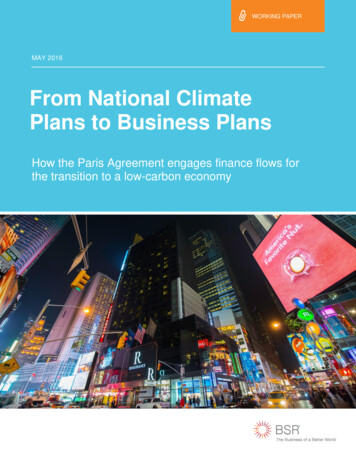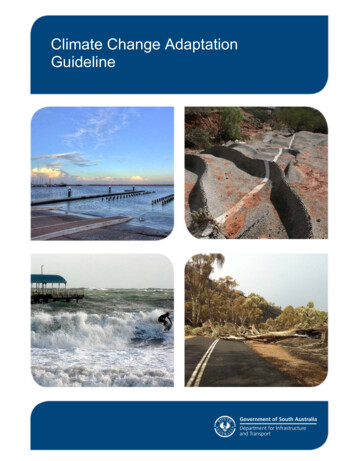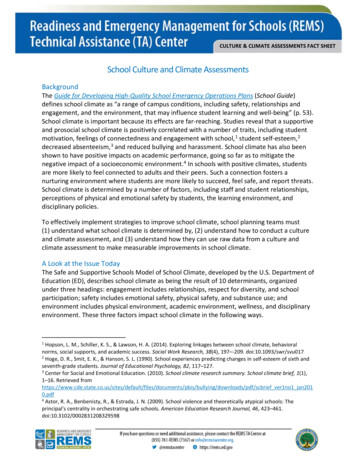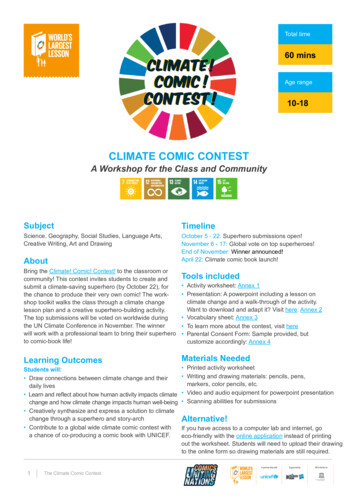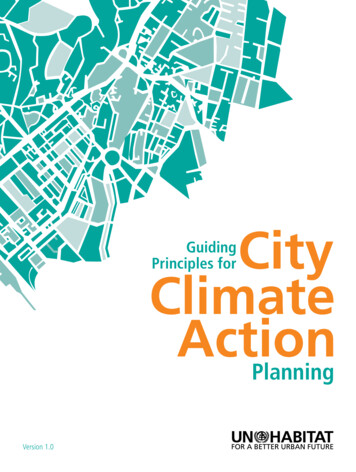
Transcription
CityClimateActionPlanningGuidingPrinciples forVersion 1.0
Guiding Principles for City Climate Action PlanningFirst published in Nairobi in 2015 by UN-HabitatCopyright United Nations Human Settlements Programme 2015Reprinted with minor changes in layout and design. April 2016All rights reservedUnited Nations Human Settlements Programme (UN-Habitat)P. O. Box 30030, 00100 Nairobi GPO KENYATel: 254-020-7623120 (Central Office)www.unhabitat.orgHS Number: HS/086/15EDisclaimerThe designations employed and the presentation of the material in this publication do not imply the expression of any opinion whatsoever on thepart of the Secretariat of the United Nations concerning the legal status of any country, territory, city or area or of its authorities, or concerningthe delimitation of its frontiers of boundaries. Views expressed in this publication do not necessarily reflect those of the United Nations HumanSettlements Programme, Cities Alliance, the United Nations, or its Member States.Excerpts may be reproduced without authorization, on condition that the source is indicated.ACKNOWLEDGMENTSCoordinator - Urban Planning and Design BranchRaf TutsUnited Nations Human Settlements Programme (UN-Habitat)Coordinator - Guiding Principles for City Climate Action PlanningRobert KehewUnited Nations Human Settlements Programme (UN-Habitat)Drafting CommitteeAlexander AylettMichael BoswellHarriet BulkeleyJuliette DanielsWee Kean FongRobert KehewCécile Martin-PhippsXiaomei TanInstitut National de la Recherche Scientifique (INRS-UCS)California Polytechnic State UniversityDurham UniversityCDP and London Climate Change PartnershipWorld Resources Institute (WRI)United Nations Human Settlements Programme (UN-Habitat)Agence de l'Environnement et de la Maîtrise de l'Énergie (ADEME)Global Environment Facility (GEF)
ContributorsCulley Thomas – AECOM Technology Corporation (AECOM); William Anderson, Jeffrey Soule – American Planning Association (APA);Ragnhild Hammer – Arendal Commune; Lene Conradi, Edvard Olai Brekke Værland – Asker Municipality; Amanda Eichel – BloombergPhilanthropies; Tim Pryce – Carbon Trust; Gian Nicola Loi, Omar Siddique – Cities Alliance; Michael Doust, Seth Schulz, Kathryn Vines– Cities Climate Leadership Group (C40); Joy Bailey, Vemuri Sasank – Cities Development Initiative for Asia (CDIA); René Sommer Lindsay– City of Copenhagen; Verónica Arias – City of Quito; Woo Soo Kim – City of Seoul; David Uushona – City of Walvis Bay; Tetsuya Nakajima– City of Yokohama; Yekbun Gurgoz, Helena Molin Valdés - Climate and Clean Air Coalition (CCAC); Batu Uprety – Climate Change Councilof Nepal; Radley Horton – Columbia University; Cynthia Rosenzweig – Columbia University / NASA; John Ingram – EcoPlan International,Inc.; Sean O'Donoghue, Debra Roberts – eThekwini Municipality; Birgit Georgi – European Environment Agency (EEA); Hervé Breton,Matthieu Robin – French Development Agency (AFD); Mathilde Gauthier, Cécile Gracy, Philippe Masset, Jean-Pierre Tabet, Eric Vesine,Nicolas Vallée – French Environment and Energy Management Agency (ADEME); Véronique Massenet – French Ministry of Ecology, SustainableDevelopment and Energy; Felipe Nunes – Fundação Estadual do Meio Ambiente do Minas Gerais in Brazil (FEAM/MG); Katrin Eisenbeiss, SarahSchneider – German Agency for International Cooperation (GIZ); Chizuru Aoki – Global Environment Facility (GEF); Katharina SchneiderRoos – Global Infrastructure Basel (GIB); Marc Weiss – Global Urban Development; Jasper Hugtenburg – H N S Landscape Architecture;Stelios Grafakos – Institute for Housing and Development Studies (IHS); David Maleki, David Wilk – Inter-American Development Bank(IADB) Emerging and Sustainable Cities Initiative (ESCI); Sarah Colenbrander – International Institute for Environment and Development (IIED);Naoki Mori, Ichiro Sato, Tomonori Sudo – Japan International Cooperation Agency (JICA); Earl Kessler; Maryke van Staden – ICLEI LocalGovernments for Sustainability (ICLEI); Shuaib Lwasa – Makerere University; Tammy Seale – Michael Baker International; Marianne Gjørn,Tønnessen Ingebjørg – Ministry of Climate and Environment of Norway; Marit Viktoria Pettersen – Ministry of Foreign Affairs of Norway;Brigitte Bariol-Mathais – Network of the French Urban Planning Public Agencies (FNAU); Signe Nyhuus – Oslo Kommune; Boris Hocks –Posad Labs; Rutger de Graaf – Research Centre Sustainable Solutions (RDM); Dr. Rose Bailey – Ricardo Energy & Environment (Ricardo AEA);Miguel Rodríguez Tejerina – SASA-Servicios Ambientales S.A.; Sandiswa Tshaka – South African Cities Network; Pete Erickson, Richard J.T.Klein – Stockholm Environment Institute (SEI); Libby Ferguson – The Climate Group; Diana Reckien, Richard Sliuzas – Twente University;Natalene Poisson – United Cities and Local Governments (UCLG); Keith Alverson, Stuart Crane, Barney Dickson, Nancy Soi, DjaheezahSubratty – United Nations Environmental Programme (UNEP); Kerry Constabile – United Nations Executive Office of the Secretary-General;Faderr Johm, Cerin Kizhakkethottam, John Alexander Maxwell, Marcus Mayr, Maria Adelaida Antonette Mias-Cea, Raf Tuts – UnitedNations Human Settlements Programme (UN-Habitat); Glenn Dolcemascolo – United Nations Office for Disaster Risk Reduction (UNISDR);Dr. Sirkku Juhola – University of Helsinki; Steve Hammer, Claire Markgraf – World Bank; Pankaj Bhatia, Holger Dalkmann, AyeshaDinshaw, Xiaoqian Jiang, Alex Kovac, Brittany Lane, Julia Martinez, Laura M. Valeri – World Resources Institute (WRI); Dana Boyer,Joshua Sperling, Alisa Zomer – Yale University on Cities and ClimateDonor SupportDevelopment of the Guiding Principles for City Climate Action Planning were generously supported by the Government of Norway (underthe Cities and Climate Change Initiative), and Cities Alliance (under the World Bank/UNEP/UN-Habitat Cities and Climate Change Joint WorkProgramme).SupportersOana BaloiFaderr JohmJohn Alexander MaxwellPublication Coordinator/EditorCerin KizhakkethottamDesign and LayoutFredrick MatairiaAustin OgolaEditorTom OsanjoPrinterUNON, Publishing Service Section, NairobiISO 14001:2004-certified
CityClimateActionPlanningGuidingPrinciples forEndorsing PartnersFrench Environment &Energy Management Agency
viGuiding Principles for City Climate Action PlanningTABLE OF CONTENTSFOREWORDS.viEXECUTIVE SUMMARY.xPREFACE .xii1.INTRODUCTION. 011.1Cities and climate action planning.011.2Guiding Principles.011.3Who should use the Guiding Principles?.042.ORGANIZATION AND PARTICIPATION. 052.1Building government capacity and support.052.2Involving the public.062.3Engaging with key groups of stakeholders.083.PLANNING PROCESS. 093.1Baseline inventories and assessments.093.2Goals, synergies, and integration.113.3Ongoing planning and evaluation.114.STRATEGIES AND ACTIONS. 134.1Defining action.134.2Selecting actions/begining to shape a strategy.164.3Programming climate actions over time.164.4The resulting climate action plan.194.5Implementing and financing city climate action plans.195.CONCLUSIONS. 21ANNEX: OTHER RESOURCES. 22
Guiding Principles for City Climate Action PlanningCase StudiesCase Study 1:Thermally-efficient low-income housing in Cape Town, South Africa. 02Case Study 2:Climate change adaptation planning in Quito, Ecuador. 07Case Study 3:Oslo – The electric vehicle capital of the world, Norway. 12Case Study 4:Jiangxi Xinyu Kongmu River Flood Controland Environmental Management Project in Xinyu City, China. 15Case Study 5:Adaptation planning in Ho Chi Minh City, Vietnam. 18FiguresFigure 1:Typical climate action planning process. 10Figure 2:Examples of climate actions for cities. 14Figure 3:Approaches to governing climate action in cities. 17Figure 4:Typical contents of a stand-alone, city-level climate action plan. 20vii
viiiGuiding Principles for City Climate Action PlanningFOREWORDbe accompanied by land use regulations that promotecompact and transit-oriented development. That is to saysectoral actions alone are not sufficient. Hence the needfor integrated climate action planning at the city level.Dr. Joan ClosUnder-Secretary-General of the United NationsExecutive Director of UN-HabitatThe present “Guiding Principles for City Climate ActionPlanning” represent the result of a year-long process todistil lessons from a wide range of partners and stakeholdersas to what provides for effective city-level climate actionplanning. Let me take this opportunity to thank partnersCities stand in the front lines of the global battle to curtailfor their many contributions. Along the way of developinggreenhouse gas emissions and build resilience to the impactsthese Guiding Principles, we hope that this process hasof climate change.yielded an important byproduct: a step in the maturationof a ‘community of practice’ in the area of city climatePlanning provides a fundamental tool for local authoritiesto use when addressing such challenges. That is becausecomprehensive and coordinated action is essential fortruly transformative action. To yield their greatest benefits,improvements in public transport, for example, mustaction planning.
Guiding Principles for City Climate Action PlanningixFOREWORDwe are facing challenges caused by climate change. However, wecan transform Seoul into a global environmental city, just like thedevelopment that we have achieved in the past.Park Won SoonMayor of Seoul and President of ICLEILocal Governments for SustainabilitySeoul has moved proactively to reduce greenhouse gas emissions. Asa result, we have seen a decline in greenhouse gas emissions since2011. We will continue our diligent efforts by implementing LowCarbon Green Growth Plan and Action Plans for Promise of Seoul:Taking Actions Against Climate Change. In particular, we launchedthe One Less Nuclear Power Plant project in 2012 together with theClimate change poses a serious threat to humanity and ourcitizens. Seoul, a megacity with more than 10 million people, hasenvironment. Considering that a significant majority of greenhousejoined efforts with its citizens to develop new environmental policiesgases released into our atmosphere come from cities, and thatto address energy crisis and tackle climate change. As a result, sixhuman settlements in all parts of the world are already impactedmonths prior to our target date, we have successfully reduced 2by this global challenge, this is where the problem and solutionmillion tonnes of oil equivalent (TOE) of energy, which is equivalentis at hand. Local governments have a key role to play here – byto the amount of energy generated by 1 nuclear power plant.planning, guiding, and managing emissions reduction in theirNow, Seoul is moving again to implement Phase 2 of the One Lesscommunities, but also by developing sustainable and innovativeNuclear Power Plant project. We will continue our effort to make asolutions that address adaptation and enhanced resilience to asustainable Earth, and a sustainable city.changing climate. This role requires leadership, foresight anddetermination.If we dream together, the dream becomes a reality. If we walktogether, it becomes our path. The Guiding Principles for CityI am ICLEI President and at the same time Mayor of Seoul, RepublicClimate Action Planning will show us the directions that we needof Korea. Our nation has undergone rapid industrialization andto take to protect our planet, Earth.urbanization over the past decades. Seoul, the capital of Korea hasenjoyed the benefits of the development but at the same time,Wishing you a successful journey!
xGuiding Principles for City Climate Action PlanningFOREWORDcity-led initiatives to enhance the focus on sustainability in cityplanning, and to help build a platform for city leaders to shareknowledge, experiences, and best practices among each other.The GEF’s new 1.5 billion flagship programme on sustainablecities aims to do exactly that, by focusing initially in 23 cities in11 countries.Naoko IshiiCEO and Chairperson,the Global Environment FacilityThe Guiding Principles for City Climate Action Planning containedin this publication give guidance and impetus to city leadersand city planners to help achieve the global 2-degree target.The guidelines provides strategic insights and new ideas, andare backed by a community of practice to help cities addressBy 2050 more than 2 billion additional people will be living inclimate change while meeting their other long-term goals suchcities, an increase of over 50% compared to today. In a rapidlyas socio-economic development and environmental protection.urbanizing world, how we design and build the cities of the futurewill be critical for global sustainable development. Compact,The development of the Guiding Principles was built on strongresilient, inclusive and resource-efficient cities can become driversinter-agency collaboration and multi-stakeholder consultation,of sustainable development and economic growth, contributingwhich will help to generate ownership of actions, encourageto both local livability and global public goods.cross-sectoral partnership, and spark complementary action.City leaders are at the forefront of the global movement towardsI join the drafting committee in their conviction that cities are thelow-carbon development. As the CEO of the Global Environmentkey to climate solution, and that the foundation for low-emissionFacility (GEF) I am extremely excited about being able to supportcities must be laid today.
Guiding Principles for City Climate Action PlanningxiFOREWORDnational governments to address the pressing needs of theircitizens. To expand their capacity to take on the challenge of climatechange, cities are joining forums that encourage collaborationbetween multiple levels of government, business, and civil society.Hundreds of cities worldwide have joined the Compact of Mayors,pledging their commitment to measure emissions, set strongertargets and take action. This past September, the UN GeneralAssembly adopted the sustainable development goals (SDGs),which specifically included a call to make cities more “inclusive,safe, resilient and sustainable.”Many city leaders are learning that climate action produces aAndrew SteerPresident of World Resources Institutewide variety of benefits for people, from boosting the localeconomy to reducing air pollution. However, many cities are alsoencountering complex challenges, as they lack the knowledge ofhow to approach climate planning in a way that is integrated,systematic, and inclusive. Conventional urban planning practicesare not up to the task. Some countries, subnational governments,Cities are a major cause of climate change and are the mostand organizations have produced detailed guides to help citiesthreatened by it. Cities occupy just two percent of land butplan, implement, and monitor climate actions. But cities are uniqueaccount for up to 70 percent of all energy-related carbon dioxideand have diverse needs. They often don’t know how best to useemissions. Many cities are also deeply vulnerable to the effects ofthe guides available to them. Most cities are learning by doing.climate change, with coastal flooding threatening the well-beingof countless communities.Guiding Principles for City Climate Action Planning fills that gap.Outlining international practices within a framework for decisionAction at the city level is therefore critical for strengtheningmaking, the document will be a go-to place for cities to identifyresilience and tackling the challenge of climate change. With morethe steps they need to take and tap into shared knowledge.than 60 percent of the land projected to become urban by 2030Through the leadership of UN-Habitat, Guiding Principles wasyet to be developed, how we approach that development willdeveloped by a range of organizations who partnered togetherhave a significant impact on our cities in the future. By focusingto contribute their unique insights and expertise. Collaborationon creating compact, connected, and coordinated cities now,like this is essential to bringing cities together to create changewe can mitigate global emissions, spur economic growth, andon the ground.improve quality of life for millions of people worldwide.Cities and urban leaders around the world should use theseA growing number of city leaders have been showing genuineGuiding Principles as the basis for climate action planning. Localleadership on climate change, taking action independently ofaction is the key to global change.
xiiGuiding Principles for City Climate Action PlanningExecutive SummaryThe Guiding Principles for City Climate Action Planningdevelopment trajectories, as well as adapt to the impactsreviews typical steps in the city-level climate action planningof climate change and build local climate resilience.process in light of a proposed set of globally applicableprinciples. These principles, shown below, developedThese Guiding Principles are intended to be applied flexibly,through a robust and open multi-stakeholder process,together with more detailed ‘how to’ manuals, to helpsupport local officials, planners and stakeholders incities more effectively play their role in reducing greenhouseclimate action planning . Such plans aim to help cities togas emissions and building climate resilience.1reduce greenhouse gas emissions and adopt low emissionGuiding Principles for City Climate Action PlanningCity climate action planning should be:AmbitiousInclusiveFairComprehensive and integratedSetting goals andimplementing actions thatevolve iteratively towardsan ambitious visionInvolving multiple city governmentdepartments, stakeholders andcommunities (with particularattention to marginalized groups),in all phases of planning andimplementationSeeking solutions thatequitably address the risks ofclimate change and share thecosts and benefits of actionacross the cityCoherently undertaking adaptation andmitigation actions across a range ofsectors within the city, as well assupporting broader regional initiativesand the realization of priorities ofhigher levels of government whenpossible and rent and verifiableDelivering local benefits andsupporting local developmentprioritiesProposing cost-effective actionsthat can realistically beimplemented by the actorsinvolved, given local mandates,finances, and capacitiesReflecting scientific knowledge andlocal understanding, and usingassessments of vulnerability andemissions and other empiricalinputs to inform decision-makingFollowing an opendecision-making process, andsetting goals that can bemeasured, reported, independentlyverified, and evaluatedENG1The present document uses an inclusive definition of the ‘city’ that includes actors at the community, town, municipal, and metropolitan levels.Lineamientos para el plan de acción climático a nivel urbanoUn plan de acción climático a nivel urbano debe ser:
AmbiciosoSPAEstablecer metas eimplementar acciones queavancen constantementehacia un objetivo ambiciosoRésuméInclusivo Guiding Principles for CityEquitativoClimate Action PlanningInvolucrar los múltiplesdepartamentos del gobierno de laciudad, actores interesados ycomunidades (con atenciónparticular a gruposmarginalizados) en todas las fasesde planeación e implementaciónLes Principes Directeurs pour la Planification de l’ActionBuscar soluciones queaborden equitativamente losriesgos del cambio climático ycompartir los costos ybeneficios de la acción a lolargo de la ciudadAmplio e integradoxiiiAsumir acciones coherentes deadaptación y mitigación en un rangoamplio de sectores dentro de laciudad, y apoyar tanto iniciativasregionales como la puesta enpráctica de las prioridades de losniveles superiores gubernamentales,cuando sea posible y apropiadode gaz à effet de serre, à adopter des trajectoires deClimatique à l’Échelle Urbaine examinent les étapes typesdéveloppement à faible émission de carbone, à s’adapterRelevantedu processusde planification urbaineViablede l’action sur leBasadoen la evidenciaTransparenteety verificableaux effetsdu changement climatiqueà renforcer laclimatà la lumièresériede principesproposésrésiliencelocaleau climat.Proporcionarbeneficios d’uneyProponeracciones rentablesyReflejarel conocimientocientíficoySeguir un proceso de toma prensiónlocaldeladecisiones abierto y establecer metasapplicables au niveau international. Ces Principes, présentésdesarrollo localimplementadas por los actoressituación, y usar la evaluación de laque puedan ser medidas, verificadasLes Principes directeurs doivent être appliqués de manièreinvolucrados, teniendo en cuentavulnerabilidad, las emisiones yde manera independiente yrigoureuxet transparent incluantplusieursacteurs,conjointementexplicatifs pluslos objetivoslocales,finanzas yavec otrasflexibleevidenciascientíficas para avec des manuelsevaluadasdecisionese informarlasl’appui des responsables locaux, des capacidadesplanificateurs et des tomardétaillésafind’aider les villes à jouer plus efficacementci-dessous, ont été élaborés grâce à un processusacteurs de la planification de l’action climatique1. De telsleur rôle dans la réduction des gaz à effet de serre et leplans entendent aider les villes à réduire leurs émissionsrenforcement de la résilience au changement climatique.Principes Directeurs pour la Planification de l’Action Climatique à l’Échelle UrbaineLa planification de l’action climatique à l’échelle des villes doit être:FRE1AmbitieuxInclusiveEquitableGlobale et intégréeEtablir des objectifs etmettre en œuvre desactions qui évoluent demanière récurrente vers unevision ambitieuseImpliquer différents départementsdes administrations municipales,acteurs et communautés (avec uneattention particulière accordée auxgroupes marginalisés) dans toutesles étapes de la planification et dela mise en œuvreRechercher des solutionséquitables aux risques poséspar le changement climatiqueet partager les coûts etbénéfices de l’action danstoute la villePrendre des mesures d’adaptation etd’atténuation de manière cohérente dansdivers secteurs urbains, appuyer lesinitiatives régionales de grande envergure,atteindre les priorités du gouvernementau plus haut niveau dans la mesure dupossible et lorsque cela est appropriéPertinenteRéalisableFondée sur les preuvesTransparente et vérifiableProduire des bénéfices locauxet renforcer les cibles dedéveloppement localProposer des actions rentablespouvant être mises en œuvre demanière réaliste par les acteursimpliqués ayant les autorisationsau niveau local, les financesetles capacitésRefléter les connaissancesscientifiques et la compréhensionlocale, utiliser les études devulnérabilité et des émissions etautres contributions empiriques pourdocumenter la prise de décisionObéir à un processus de prise dedécision ouvertet fixer des objectifspouvant être mesurés, vérifiés demanière indépendante et évaluésCe document utilise une définition inclusive de la “ville” qui en globe les acteurs aux niveaux communautaire, urbain, municipal et métropolitain.
xivGuiding Principles for City Climate Action PlanningPREFACE
xvGuiding Principles for City Climate Action PlanningPREFACE1.It is now clear that cities are at the forefront ofconsultation with partners and a peer review process.urgently needed global action on climate change.This process has involved cities, city networks, nationalThey are playing a critical role in global efforts to bringgovernments,down greenhouse gas emissions, while also reducingand bilateral financial institutions, non-governmentalthe vulnerabilities of people and assets and adaptingorganizations, universities and research institutions,to the impacts of a changing climate. As local officialsconsultants, and United Nations agencies and bodiesand stakeholders move forward with these efforts,(please see Acknowledgements and Endorsements).these Guiding Principles for City Climate Action PlanningThe Guiding Principles are also grounded in the existingprovide an international benchmark for city-level climatescientific consensus about climate change, as well asaction planning2. Based on international best practices,current research findings on what constitutes effectivethese Guiding Principles offer principles applied toclimate action planning at the city level. Links to corethe typical steps in this planning process. As such, thedocuments referred to during preparation of thepublication provides a framework that cities can use,present Guidelines, as well as more detailed manualstogether with more detailed ‘how-to’ manuals, in orderand other resource materials, are provided through ato more effectively play their role in reducing greenhousewebpage introduced in Annex.developmentagencies,multilateralgas emissions and building climate resilience.3.Finally the present document is designated asThe Guiding Principles were developed through a‘Version 1.0’, as a sign that, as knowledge accumulatesrobust, open, and transparent multi-stakeholder process.and a community of practice continues to mature,This included in-person meetings and workshopspartners intend to update these Guiding Principles forwith stakeholders and experts, as well as a widerCity Climate Action Planning to reflect new findings.2.2The present document uses an inclusive definition of the “city’ that includes actors at the community, town, municipal, and metropolitan levels.
01Guiding Principles for City Climate Action Planning1 INTRODUCTION1.14.Cities and climate action planningCities are playing a vital role in the global response6.These Guiding Principles for City Climate ActionPlanning provide city governments and their partnersto climate change by curbing their greenhouse gaswithemissions and adapting to the effects of a changingnecessary to realize their potential and to contributeclimate. Local governments are central to these efforts.to this global effort. They support planning that aimsThey lead climate action by framing strategies andto reduce greenhouse gas emissions and adopt lowprogrammes, integrating such actions into ongoingemission development trajectories (mitigation), as wellurban development, and forging the partnershipsas adapt to the impacts of climate change (adaptation)necessary for effective climate responses.and build local climate resilience. They are based on anthefundamentalprincip
Juliette Daniels CDP and London Climate Change Partnership Wee Kean Fong World Resources Institute (WRI) Robert Kehew United Nations Human Settlements Programme (UN-Habitat) Cécile Martin-Phipps Agence de l'Environnement et de la Maîtrise de l'Éner







